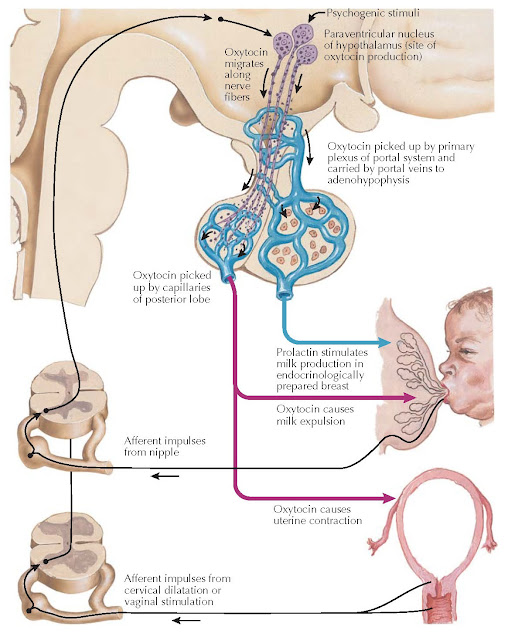SECRETION AND
ACTION OF OXYTOCIN
The physiologic roles of oxytocin are smooth muscle activation promoting milk letdown with breastfeeding and uterine myometrial contraction at parturition. The milk-producing compartments of the breast are composed of multiple alveolar clusters of milk-producing (glandular) cells surrounded by specialized myoepithelial cells. Prolactin stimulates milk production in endocrinologically prepared breasts. The alveoli are connected to ductules that lead to large ducts that lead to the nipple. The glandular cells have receptors for oxytocin and cause myoepithelial contraction when activated. In addition, oxytocin acts on ductal myoepithelial cells to enhance milk flow to the nipple. Activation of nipple tactile and mechanoreceptors by suckling sends an afferent signal to the spinal cord and from the spinal cord to the oxytocinergic neurons in the supraoptic and paraventricular nuclei. Oxytocin is then released from the posterior pituitary in a pulsatile fashion that effects a pumping action on the alveoli, promoting emptying of milk from the alveoli. In the absence of oxytocin, only approximately 30% of stored milk is released during nursing. There is a latent period of approximately 30 seconds between the onset of suckling and commencement of milk flow. Psychogenic stimuli can also trigger milk letdown in lactating mothers. Changes in estrogen and progesterone at the time of parturition help modulate the lactation response both by affecting oxytocin synthesis and secretion and by impacting oxytocin receptors.
 |
| Plate 1-25 |
Oxytocin is a powerful uterotonic
stimulant for contractions, and oxytocin secretion increases with the
expulsive phase of parturition. During pregnancy, the uterus is maintained in a
quiet state by the actions of progesterone and relaxin. The initiation of labor
is accomplished by a relative increase in estrogen activation and a decrease in progesterone
activation. There is a 200-fold increase in the responsiveness of the uterus to
oxytocin as parturition approaches.
Synthetic oxytocin administration is
a clinically proven method of labor induction. Oxytocin is administered
intravenously at an escalating dose until there is normal progression of labor,
strong contractions occurring at 2- to 3-minute intervals, or uterine
activity reaches 150 to 350 Montevideo units (the peak strength of contractions
in mm Hg measured by an internal monitor multiplied by their frequency over 10
minutes). When uterotonic drugs are administered, continuous monitoring of
fetal heart rate and uterine activity helps prevent induction of excessive or
inadequate uterine activity. Other methods used to induce labor include
“membrane stripping,” amniotomy, intra-vaginal administration of prostaglandins
E2 or E1, and breast stimulation.




